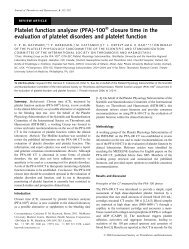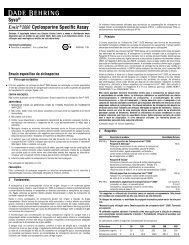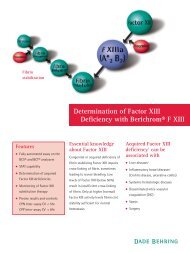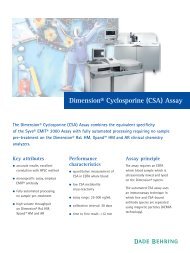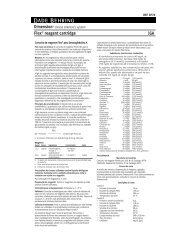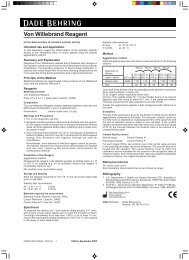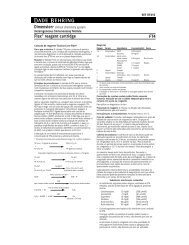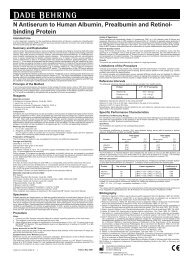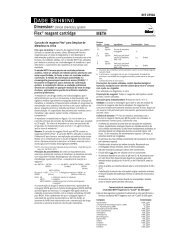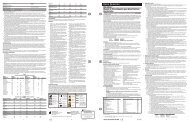Berichrom® Heparin - Medcorp
Berichrom® Heparin - Medcorp
Berichrom® Heparin - Medcorp
You also want an ePaper? Increase the reach of your titles
YUMPU automatically turns print PDFs into web optimized ePapers that Google loves.
Berichrom ® <strong>Heparin</strong><br />
Intended Use and Application<br />
Berichrom <strong>Heparin</strong> is a chromogenic assay for the determination of the activity of heparin<br />
in plasma and for the monitoring of heparin therapy.<br />
Summary and Explanation<br />
<strong>Heparin</strong> considerably accelerates the inactivation of coagulation factor Xa and thrombin by<br />
antithrombin III. For this reason unfractionated and low-molecular-weight heparin preparations<br />
are widely used as therapeutic anticoagulants. Due to numerous influences the effect<br />
of an identical dose of heparin varies from patient to patient. Using Berichrom <strong>Heparin</strong> it is<br />
possible to monitor therapy both with low-molecular-weight (LMW) and unfractionated<br />
heparin preparations.<br />
Principle of the Method<br />
Factor Xa is inactivated by AT III during the incubation phase of the test. This reaction is<br />
catalyzed by heparin. Dextran sulfate (DS) releases heparin which has bound to interfering<br />
factors and thus makes it accessible to the assay. The quantity of F Xa remaining after the<br />
incubation phase is determined via the increase in absorbance at 405 nm, using a<br />
chromogenic substrate in a kinetic test.<br />
heparin bound<br />
+ DS<br />
heparin<br />
F Xa + AT III sample<br />
excess<br />
F XA<br />
Chromogenic substrate<br />
residue<br />
OWLD G11 E0532 (1211) H 1<br />
> DS bound<br />
+ heparin free<br />
> [F Xa-AT III] + F XAresidue<br />
> tripeptide + dye<br />
Reagents<br />
Materials provided<br />
Test kit for 3 x 20 semi-micro tests, Code No. OWLD<br />
3 x for 10 ml Factor Xa Reagent<br />
3 x for 10 ml Dextran Sulfate Reagent<br />
3 x for 11 ml AT III Reagent<br />
3 x for 12 ml Substrate Reagent<br />
Composition<br />
Factor Xa Reagent: lyophilized; human plasma fraction with the additives Tris (6 g/l), sodium<br />
chloride (12 g/l) and EDTA (0.74 g/l)<br />
Preservatives: sodium azide (< 1 g/l)<br />
Dextran Sulfate Reagent, lyophilized; concentration in the working solution: 0.02 g/l.<br />
AT III Reagent (human), lyophilized; concentration in the working solution: 1 IU/ml.<br />
Preservatives: sodium azide (< 1 g/l)<br />
Substrate Reagent, lyophilized; concentration in the working solution: 4 mmol/l Z-D-leugly-arg-ANBA-methyl<br />
amide.<br />
Warnings and precautions<br />
1. For In Vitro Diagnostic Use.<br />
2. Reagents containing sodium azide must be handled with due caution:<br />
Do not ingest or allow to contact skin or mucous membranes! Sodium azide can form<br />
explosive azides when contacting heavy metals such as copper or lead!<br />
3. Each individual blood donation for use in manufacture of the Factor Xa Reagent or AT III<br />
Reagent is tested for hepatitis B surface antigen, anti-HCV, anti-HIV1 and anti-HIV2 by<br />
FDA-required test. Only donations with negative findings are used for manufacture.<br />
Furthermore, during the production process, the materials of human origin are heated<br />
in solution at +60°C for 10 hours for the purpose of virus inactivation.<br />
Nevertheless, since absence of infectious agents cannot be proven, all materials obtained<br />
from human blood should always be handled with due care, observing the precautions<br />
recommended for biohazardous material 3 .<br />
Reagent preparation<br />
Dextran Sulfate Reagent: Dissolve in the labelled amount of distilled water.<br />
Factor Xa Reagent: Dissolve in the labelled amount of reconstituted Dextran Sulfate Reagent<br />
and warm to 37°C before use.<br />
AT III Reagent: Dissolve in the labelled amount of distilled water and warm to room<br />
temperature before use.<br />
Substrate Reagent: Dissolve in the labelled amount of distilled water and warm to 37 °C<br />
before use.<br />
Storage and stability<br />
Store the test kit unopened at +2 to +8 °C and use by the expiration date given on the label.<br />
Stability after reconstitution:<br />
Temperature Factor Xa AT III Substrate Reagent<br />
+37°C 4 hours – 1 week<br />
+15°C to +25 °C 3 days 1 week 2 weeks<br />
+2 to +8°C 2 weeks 2 weeks 6 weeks<br />
–20°C 2 months 2 months 6 months<br />
In the original vial the solutions can be frozen up to 3 times.<br />
Materials required but not provided<br />
Standard Human Plasma, Code No. ORKL<br />
Acetic acid 20% (only for the two-point method)<br />
Specimens<br />
To obtain the plasma, carefully mix 1 part sodium citrate solution (0.11 mol/l) with 9 parts<br />
venous blood, avoiding the formation of foam. Centrifuge immediately at no less than<br />
1500 x g for at least 10 min.<br />
Stability of the sample:<br />
–20°C<br />
1 month<br />
+15 to +25°C 8 hours<br />
Plasma stored at –20°C is to be thawed within 10 minutes at 37 °C after which the assay is<br />
to be performed within 8 hours.<br />
Method<br />
Procedure<br />
cuvette: 1 cm path length<br />
wavelength: 405 nm<br />
test temperature: +37°C<br />
Pre-warm the Factor Xa Reagent, Substrate Reagent and the plastic cuvettes/tubes to<br />
37°C, and the AT III Reagent to room temperature (+15° to +25 °C).<br />
Edition August 2000<br />
Kinetic method<br />
Plasma sample 150 µl<br />
AT III Reagent 150 µl<br />
Factor Xa Reagent 500 µl<br />
Mix and incubate for exactly 1 min at 37°C<br />
Substrate Reagent 100 µl<br />
Mix and determine ∆A 405 nm/min<br />
Test mixture for the kinetic test on the Chromotimer: Using the same incubation times the<br />
volumes of the solutions used have to be halved.<br />
Manual two-point method (semi-micro test)<br />
Sample Sample blank<br />
Acetic acid 20% – 500 µl<br />
Sample 150 µl 150 µl<br />
AT III Reagent 150 µl 150 µl<br />
Factor Xa Reagent 500 µl 500 µl<br />
Mix and incubate for exactly 1 min at 37°C (timed by instrument)<br />
Substrate Reagent 100 µl 100 µl<br />
Mix immediately and after exactly 1 min add: (timed by instrument)<br />
Acetic acid 20% 500 µl<br />
Mix immediately and determine the absorbance against the blank<br />
within 2 hours.<br />
Evaluation<br />
The results are evaluated using a reference curve which must be established prior to the<br />
test using the heparin preparation administered for therapy and the same method of analysis.<br />
Dilute the treatment heparin to 10 IU/ml with isotonic saline (0.9%), then dilute 100 µl of the<br />
resulting dilution with 900 µl of heparin-free pooled plasma or standard plasma (e.g. Standard<br />
Human Plasma) to obtain a concentration of 1 IU/ml. The dilutions required for establishing<br />
the reference curve (range 0 to 1 IU heparin/ml) are obtained as follows:<br />
heparin normal or standard heparinized<br />
concentration plasma plasma 1 IU/ml<br />
IU/ml µl µl<br />
1.01 1110 1000<br />
0.75 1250 1750<br />
0.51 1500 1500<br />
0.25 1750 1250<br />
0.11 1900 1100<br />
0.11 1000 1110<br />
Notes<br />
1. Doubling or halving the volumes used in the assay mixtures has no effect on the<br />
evaluation.<br />
2. The plasma is used in undiluted form. If the values are above the calibrated measurement<br />
range, the sample must be diluted with the AT III solution or a heparin-free normal<br />
plasma (e.g. Standard Human Plasma); the results obtained are then to be corrected for<br />
the dilution factor.<br />
3. If the heparin concentration is very low, the sensitivity of the test system can be increased<br />
by prolonging the incubation period to 3 minutes. In this case te results must be evaluated<br />
using a reference curve which has similarly been established using a 3-minute incubation<br />
period and additional standard dilutions.<br />
4. Special assay protocols for autoanalyzers are available on request.<br />
Internal quality control<br />
Quality control materials containing at least two levels of heparin should be included with<br />
each batch of product sample. If the control materials do not produce the expected results,<br />
patient results must not be reported.<br />
The following can be used for quality control:<br />
A heparin-free normal plasma (e.g. Control Plasma N). This provides a check on the stability<br />
of the reagent and on the zero-point of the reference curve.<br />
A normal plasma adjusted to an appropriate concentration (e.g. 0.5 IU/ml) with the heparin<br />
to be assayed. This provides a check on the sensitivity and recovery.<br />
Limitations and interferences<br />
The incubation periods must be exactly observed in order to obtain reproducible results.<br />
Specific Performance Characteristics<br />
Sensitivity<br />
The limit of detection for an unfractionated heparin is 0.05 IU/ml.<br />
Specificity<br />
The heparin determination using Berichrom <strong>Heparin</strong> is not disturbed by platelet factor 4<br />
(PF4).<br />
Precision and reproducibility<br />
For heparin concentrations of 0.5 IU/ml the coefficient of variation in the series falls between<br />
4.0 and 7.0% and from day to day between 6.9 and 7.1%.<br />
Method comparison<br />
In a comparison of Berichrom <strong>Heparin</strong> with another chromogenic method correlation<br />
coefficients of 0.94 and 0.97 were found.<br />
Bibliography<br />
1. Levine, S. P. et al.: The Effect of Platelet Factor 4 (PF4) on Assays of Plasma <strong>Heparin</strong>.<br />
Brit. J. Haematol. 57 (1984) 585–596<br />
2. Teien, A. N. and Lie, M.: Evaluation of an Amidolytic <strong>Heparin</strong> Assay Method: Increased<br />
Sensitivity by Adding Purified Antithrombin III. Thromb. Res. 10 (1977) 399–410<br />
3. Biosafety in Microbiological and Biomedical Laboratories, U. S. Department of Health<br />
and Human Services, Washington 1993 (HHS Publication No. (CDC) 93–8395)<br />
Manufacturer:<br />
USA Distributor:<br />
Dade Behring Marburg GmbH<br />
Emil-von-Behring-Str. 76<br />
D-35041 Marburg/Germany<br />
Dade Behring Inc.<br />
Newark, DE 19714 U.S.A.
Berichrom ® <strong>Heparin</strong><br />
Anwendungsbereich und -zweck<br />
Berichrom <strong>Heparin</strong> ist ein chromogener Test zur Bestimmung der Aktivität von <strong>Heparin</strong> in<br />
Plasma und zur Überwachung der <strong>Heparin</strong>therapie.<br />
Diagnostische Bedeutung<br />
<strong>Heparin</strong> beschleunigt die Inaktivierung von Gerinnungsfaktor Xa und Thrombin durch<br />
Antithrombin III erheblich. Daher finden unfraktionierte und niedermolekulare <strong>Heparin</strong>-Präparate<br />
verbreitete therapeutische Anwendung als Antikoagulans. Infolge vielfacher Einflüsse<br />
schwankt die <strong>Heparin</strong>wirkung von Patient zu Patient trotz gleicher Dosierung. Mit<br />
Berichrom <strong>Heparin</strong> kann die Therapie sowohl mit niedermolekularen (LMW) als auch mit<br />
unfraktionierten <strong>Heparin</strong>-Präparaten verfolgt werden.<br />
Prinzip der Methode<br />
Faktor Xa wird in der Inkubationsphase durch AT III inaktiviert. Diese Reaktion wird durch<br />
<strong>Heparin</strong> katalysiert. Dextransulfat (DS) setzt an Störfaktoren gebundenes <strong>Heparin</strong> wieder<br />
frei und macht es der Bestimmung zugänglich. Der nach der Inkubationsphase verbliebene<br />
Faktor Xa wird in einem kinetischen Test über die Extinktionszunahme bei 405 nm mittels<br />
eines chromogenen Substrats bestimmt.<br />
<strong>Heparin</strong> gebunden<br />
+ DS<br />
> DS gebunden<br />
+ <strong>Heparin</strong> frei<br />
<strong>Heparin</strong><br />
F Xa + AT III Probe<br />
Überschuß<br />
> [F Xa-AT III] + F XARest<br />
F XA<br />
Chromogenes Substrat<br />
Rest > Tripeptid + Farbstoff<br />
Reagenzien<br />
Inhalt der Handelspackung<br />
Testkit für 3 x 20 Halbmikro-Ansätze, Bestell Nr. OWLD<br />
3 x für 10 ml Faktor Xa-Reagenz<br />
3 x für 10 ml Dextransulfat-Reagenz<br />
3 x für 11 ml ATIII-Reagenz<br />
3 x für 12 ml Substrat-Reagenz<br />
Zusammensetzung<br />
Faktor Xa-Reagenz: lyophilisiert; Plasma-Fraktion (human) mit Zusatz von Tris (6 g/l),<br />
Natriumchlorid (12 g/l) und EDTA (0,74 g/l)<br />
Konservierungsmittel: Natriumazid (< 1 g/l)<br />
Dextransulfat-Reagenz, lyophilisiert; Konzentration in der Gebrauchslösung: 0,02 g/l.<br />
AT III-Reagenz (human), lyophilisiert; Konzentration in der Gebrauchslösung: 1 IU/ml.<br />
Konservierungsmittel: Natriumazid (< 1 g/l)<br />
Substrat-Reagenz, lyophilisiert; Konzentration in der Gebrauchslösung: Z-D-Leu-Gly-Arg-<br />
ANBA-methyl-amid 4 mmol/l.<br />
Warnungen und Vorsichtsmaßnahmen<br />
1. Nur zur in vitro diagnostischen Anwendung<br />
2. Beim Umgang mit Natriumazid-haltigen In-vitro-Diagnostica ist zu beachten:<br />
Verschlucken und Kontakt mit Haut oder Schleimhäuten vermeiden. Natriumazid kann<br />
mit Schwermetallen, wie Kupfer oder Blei, explosive Azide bilden.<br />
3. Jede individuelle Blutspende, die zur Herstellung von Faktor Xa-Reagenz oder AT III-<br />
Reagenz vorgesehen war, wurde auf Hepatitis Bs-Antigen, auf Anti-HCV, auf Anti-HIV1<br />
und auf Anti-HIV2 untersucht. Für die Herstellung wurden nur Spenden mit negativem<br />
Befund verwendet.<br />
Außerdem werden die Ausgangsmaterialien humanen Ursprungs beim Herstellungsprozess<br />
zur Virusinaktivierung in Lösung 10 Stunden bei +60°C erhitzt.<br />
Unabhängig davon sollten alle aus menschlichem Blut gewonnenen Materialien wegen<br />
nie auszuschließender Gefährdung durch Krankheitserreger mit angemessener Sorgfalt<br />
unter Einhaltung der bei Biogefährdung empfohlenen Sicherheitsmaßnahmen gehandhabt<br />
werden 3 .<br />
Vorbereitung der Reagenzien<br />
Dextransulfat-Reagenz: Mit der auf dem Etikett angegebenen Menge dest. Wasser lösen.<br />
Faktor Xa-Reagenz: Mit der auf dem Etikett angegebenen Menge des rekonstituierten<br />
Dextransulfat-Reagenzes einlösen und vor Gebrauch auf 37°C temperieren.<br />
AT III-Reagenz: Mit der auf dem Etikett angegebenen Menge dest. Wasser lösen und vor<br />
Gebrauch auf Raumtemperatur temperieren.<br />
Substrat-Reagenz: Mit der auf dem Etikett angegebenen Menge dest. Wasser lösen und<br />
vor Gebrauch auf 37°C temperieren.<br />
Haltbarkeit und Lagerungsbedingungen<br />
Der Testkit ist, ungeöffnet bei +2 bis +8°C gelagert, bis zu dem auf dem Etikett angegebenen<br />
Datum verwendbar.<br />
Haltbarkeit nach Rekonstitution:<br />
Temperatur Faktor Xa AT III Substrat-Reagenz<br />
+37 °C 4 Stunden – 1 Woche<br />
+15°C bis +25°C 3 Tage 1 Woche 2 Wochen<br />
+2 bis +8°C 2 Wochen 2 Wochen 6 Wochen<br />
–20°C 2 Monate 2 Monate 6 Monate<br />
Die Lösungen können in der Originalflasche bis zu 3mal eingefroren werden.<br />
Zusätzlich benötigte Materialien<br />
Standard-Human-Plasma, Bestell-Nr. ORKL<br />
Essigsäure 20%ig (nur für die Zweipunkt-Methode)<br />
Untersuchungsmaterial<br />
Zur Plasmagewinnung 1 Teil Natriumcitrat-Lösung 0,11 mol/l mit 9 Teilen Venenblut sorgfältig<br />
unter Vermeidung von Schaumbildung mischen. Sofort mindestens10 min bei mindestens<br />
1500 x g zentrifugieren.<br />
Stabilität der Probe:<br />
–20°C<br />
1 Monat<br />
+15 bis +25°C 8 Stunden<br />
Bei –20 °C gelagerte Plasmen innerhalb von 10 min bei 37 °C auftauen und die Bestimmung<br />
dann innerhalb von 8 Stunden durchführen.<br />
Methodik<br />
Testdurchführung<br />
Küvette: 1 cm Schichtdicke<br />
Wellenlänge: 405 nm<br />
Testtemperatur: +37 °C<br />
Faktor Xa-Reagenz, Substrat-Reagenz sowie die Kunststoffküvetten bzw. -röhrchen auf<br />
37°C, ATIII-Reagenz auf Raumtemperatur (+15° bis +25°C) vorwärmen.<br />
Kinetische Methode<br />
Probe 150 µl<br />
ATIII-Reagenz 150 µl<br />
Faktor Xa-Reagenz 500 µl<br />
mischen und genau 1 min bei 37°C inkubieren.<br />
Substrat-Reagenz 100 µl<br />
mischen und ∆E 405 nm<br />
/min bestimmen.<br />
Testansatz für Chromotimer: Bei gleichen Inkubationszeiten ist das Volumen der verwendeten<br />
Lösungen zu halbieren.<br />
Manuelle Zweipunkt-Methode (Halbmikroansatz)<br />
Probe Probenleerwert<br />
Essigsäure 20% – 500 µl<br />
Probe 150 µl 150 µl<br />
ATIII-Reagenz 150 µl 150 µl<br />
Faktor Xa-Reagenz 500 µl 500 µl<br />
mischen und genau 1 min bei 37°C inkubieren.<br />
Substrat-Reagenz 100 µl 100 µl<br />
sofort mischen und nach genau 1 min Zugabe von:<br />
Essigsäure 20% 500 µl<br />
sofort mischen und die Extinktion innerhalb von 2 Stunden gegen den Probenleerwert<br />
bestimmen.<br />
Auswertung<br />
Die Auswertung erfolgt anhand einer Bezugskurve, die vorher mit dem verwendeten <strong>Heparin</strong>-<br />
Präparat und der gleichen Analysenmethode zu erstellen ist. Das zur in der Therapie verwendete<br />
<strong>Heparin</strong>-Präparat wird mit isotonischer Kochsalzlösung (0,9%) auf 10 IU/ml verdünnt.<br />
100 µl dieser Verdünnung mit 900 µl heparinfreiem Pool- oder Standardplasma (z.B.<br />
Standard-Human-Plasma) verdünnen, um eine Konzentration von 1 IU/ml zu erhalten. Die<br />
Verdünnungen für die Bezugskurve (Bereich 0-1 IU <strong>Heparin</strong>/ml) erhält man nach folgender<br />
Tabelle:<br />
<strong>Heparin</strong>- Normal- oder <strong>Heparin</strong>plasma<br />
Konzentration Standardplasma 1 IU/ml<br />
IU/ml µl µl<br />
1,01 1110 1000<br />
0,75 1250 750<br />
0,51 1500 1500<br />
0,25 1750 1250<br />
0,11 1900 1100<br />
0,11 1000 1110<br />
Anmerkungen<br />
1. Eine Volumenverdopplung oder -halbierung hat keine Auswirkung auf die Auswertung.<br />
2. Das Plasma wird unverdünnt eingesetzt. Wenn die Werte oberhalb des kalibrierten<br />
Meßbereichs liegen, ist mit der ATIII-Lösung oder einem heparinfreien Normalplasma<br />
(z.B. Standard-Human-Plasma) zu verdünnen. Die erhaltenen Ergebnisse sind entsprechend<br />
umzurechnen.<br />
3. Wenn die <strong>Heparin</strong>-Konzentration sehr niedrig liegt, kann durch die Verlängerung der<br />
Inkubationszeit auf 3 Minuten die Empfindlichkeit des Testsystems gesteigert werden.<br />
Es muß dann an einer Referenzkurve ausgewertet werden, die ebenfalls mit einer 3-<br />
minütigen Inkubation und zusätzlichen Standardverdünnungen erstellt wurde.<br />
4. Spezielle Automatenvorschriften sind auf Anfrage erhältlich.<br />
Interne Qualitätskontrolle<br />
Für jede Meßreihe sollten mindestens zwei Kontrollen mit unterschiedlichen <strong>Heparin</strong>-Konzentrationen<br />
mitgeführt werden. Werden die erwarteten Werte nicht gefunden, so können<br />
die Ergebnisse der Patientenproben nicht verwertet werden.<br />
Als Kontrolle kann verwendet werden:<br />
Ein heparinfreies Normalplasma (z.B. Kontroll-Plasma N). Damit kann die Stabilität des<br />
Reagenzes und der Null-Punkt der Referenzkurve überprüft werden.<br />
Ein mit dem zu messenden <strong>Heparin</strong>-Präparat auf eine entsprechende Konzentration (z.B.<br />
0,5 IU/ml) gebrachtes Normalplasma (z.B. Kontroll-Plasma N). Damit können Sensitivität<br />
und Wiederfindung überprüft werden.<br />
Einschränkungen und Fehlerquellen<br />
Die Inkubationszeiten müssen genau eingehalten werden, um reproduzierbare Ergebnisse<br />
zu erhalten.<br />
Leistungsmerkmale des Tests<br />
Empfindlichkeit<br />
Die Nachweisgrenze für ein unfraktioniertes <strong>Heparin</strong> lag bei 0,05 IU/ml.<br />
Spezifität<br />
Die <strong>Heparin</strong>-Bestimmung mit Berichrom <strong>Heparin</strong> wird durch Plättchenfaktor 4 (PF4) nicht<br />
gestört.<br />
Präzision und Reproduzierbarkeit<br />
Für <strong>Heparin</strong>konzentrationen von 0,5 IU/ml liegt der Variationskoeffizient in der Serie zwischen<br />
4,0 und 7,0% und von Tag zu Tag zwischen 6,9 und 7,1%.<br />
Methodenvergleich<br />
Bei einem Vergleich von Berichrom <strong>Heparin</strong> mit einer anderen chromogenen Methode<br />
wurden Korrelationskoeffizienten von 0,94 und 0,97 gefunden.<br />
Literatur<br />
1. Levine, S. P. et al.: The Effect of Platelet Factor 4 (PF4) on Assays of Plasma <strong>Heparin</strong>.<br />
Brit. J. Haematol. 57 (1984) 585–596<br />
2. Teien, A. N. and Lie, M.: Evaluation of an Amidolytic <strong>Heparin</strong> Assay Method: Increased<br />
Sensitivity by Adding Purified Antithrombin III. Thromb. Res. 10 (1977) 399–410<br />
3. Biosafety in Microbiological and Biomedical Laboratories, U. S. Department of Health<br />
and Human Services, Washington 1993 (HHS Publication No. (CDC) 93–8395)<br />
Hersteller:<br />
Vertreiber Schweiz:<br />
Dade Behring Marburg GmbH<br />
Emil-von-Behring-Str. 76<br />
D-35041 Marburg<br />
Dade Behring AG<br />
Bonnstrasse 9<br />
CH-3186 Düdingen<br />
Schweiz<br />
OWLD G11 E0532 (1211) H 2<br />
Ausgabe August 2000
Berichrom ® Héparine<br />
Domaine d’utilisation et indication<br />
Berichrom Héparine est un test chromogénique pour la détermination de l’activité d’héparine<br />
dans le plasma et pour la surveillance des héparinothérapies.<br />
Intérêt diagnostique<br />
L’héparine accélère considérablement l’inactivation du facteur Xa de la coagulation et de la<br />
thrombine par l’antithrombine III. Ainsi les préparations d’héparine non-fractionnées et de<br />
bas poids moléculaires trouvent-elles une large application thérapeutique comme anticoagulants.<br />
Malgré une posologie identique, de nombreux facteurs influencent l’effet de<br />
l’héparine variable d’un patient à l’autre. Le test Berichrom Héparine permet le suivi des<br />
traitements utilisant aussi bien des héparines de bas poids moléculaires (HBPM) que des<br />
héparines non-fractionnées (HNF).<br />
Principe de la méthode<br />
Pendant la phase d’incubation, le facteur Xa est inactivé par l’AT III. Cette réaction est<br />
catalysée par l’héparine. Du sulfate de dextran (SD) libère de nouveau l’héparine liée à<br />
des facteurs interférants, et la rend ainsi mesurable. Le F Xa qui subsiste après la phase<br />
d’incubation est mesuré dans un test cinétique par l’augmentation de la densité optique à<br />
405 nm à l’aide d’un substrat chromogène.<br />
Héparine liee<br />
+ SD<br />
> SD lié<br />
+ héparine libre<br />
héparine<br />
F Xa + AT III échantillon<br />
en excés<br />
> [F Xa-AT III] + F XArésiduel<br />
F XA<br />
substrat chromogène<br />
résiduel > tripeptide + colorant<br />
Réactifs<br />
Contenu du coffret<br />
Coffret pour 3 x 20 semi-micro-tests, code OWLD<br />
3 x pour 10 ml de Réactif F Xa<br />
3 x pour 10 ml de Réactif sulfate de dextran<br />
3 x pour 11 ml de Réactif AT III<br />
3 x pour 12 ml de Réactif substrat<br />
Composition<br />
Réactif F Xa, lyophilisé; fraction plasmatique (humaine) additionnée de Tris (6 g/l), de<br />
chlorure de sodium (12 g/l) et d’EDTA (0,74 g/l).<br />
Agents de conservation: azide de sodium (< 1 g/l)<br />
Réactif sulfate de dextran, lyophilisé; concentration dans la solution d’emploi: 0,02 g/l.<br />
Réactif AT III (humain), lyophilisé; concentration dans la solution d’emploi: 1 UI/ml<br />
Agents de conservation: azide de sodium (< 1 g/l)<br />
Réactif substrat, lyophilisé; concentration dans la solution d’emploi: 4 mmol/l de Z-D-Leu-<br />
Gly-Arg-ANBA-méthylamide.<br />
Mises en garde et précautions d’emploi<br />
1. Ne doit être employé que pour un usage in vitro<br />
2. Les réactifs contenant de l’azide de sodium doivent être manipulés avec précaution :<br />
ne pas avaler et éviter tout contact avec la peau et les muqueuses. L’azide de sodium<br />
peut devenir explosif au contact de métaux lourds comme le cuivre ou le plomb.<br />
3. Tout don de sang individuel prévu pour la préparation du Réactif Facteur Xa ou du<br />
Réactif AT III a été testé vis-à-vis de l’antigène de surface de l'Hépatite B, de l’anticorps<br />
anti-VHC, de l’anticorps anti-VIH 1 et de l’anticorps anti-VIH 2. Seuls les dons trouvés<br />
négatifs ont été utilisés.<br />
Par ailleurs, au cours du processus de fabrication, les produits d’origine humaine en<br />
solution sont chauffés 10 heures à +60°C pour inactiver les virus.<br />
Néanmoins, toutes les préparations obtenues à partir de sang humain doivent être<br />
manipulées avec les précautions nécessaires en cas de risque biologique, dans la mesure<br />
où l’on ne peut exclure totalement un risque d’infection 3 .<br />
Préparation des réactifs<br />
Réactif sulfate de dextran: reconstituer le lyophilisat avec la quantité d’eau distillée indiquée<br />
sur l’étiquette.<br />
Réactif Facteur Xa: reconstituer le lyophilisat avec la quantité de sulfate de dextran<br />
reconstitué indiquée sur l’étiquette, et porter le réactif à +37 °C avant son emploi.<br />
Réactif AT III: le reconstituer avec la quantité d’eau distillée indiquée sur l’étiquette, puis le<br />
porter à la température ambiante avant son emploi.<br />
Réactif substrat: le reconstituer avec la quantité d’eau distillée indiquée sur l’étiquette, et le<br />
porter à +37°C avant son emploi.<br />
Stabilités et conditions de conservation<br />
Dans leur conditionnement d’origine non ouvert, les réactifs se conservent à +2/+8°C jusqu’à<br />
la date de péremption indiquée sur l’étiquette.<br />
Stabilités après reconstitution:<br />
Température Facteur Xa AT III reactif-substrat<br />
+37°C 4 heures – 1 semaine<br />
+15/+25°C 3 jours 1 semaine 2 semaines<br />
+2/+8°C 2 semaines 2 semaines 6 semaines<br />
–20°C 2 mois 2 mois 6 mois<br />
Les solutions peuvent être congelées jusqu’à 3 fois dans leur flacon d’origine.<br />
Autres réactifs nécessaires<br />
Plasma standard humain, code ORKL<br />
Acide acétique à 20% (uniquement pour la méthode en deux points)<br />
Echantillons de patients<br />
Pour obtenir les plasmas, prélever 1 volume de solution de citrate de sodium (0,11 mol/l)<br />
avec 9 volumes de sang veineux, et mélanger avec précaution en évitant la formation de<br />
mousse. Centrifuger aussitôt pendant au moins 10 min à au moins 1500 g.<br />
Stabilité de l’échantillon:<br />
à –20 °C: 1 mois<br />
à +15/+25 °C 8 heures<br />
Les plasmas congelés a –20°C doivent être décongelés en 10 min à 37°C, et testés dans<br />
les 8 heures qui suivent.<br />
Méthode<br />
Réalisation du test<br />
Cuve:<br />
1 cm de trajet optique<br />
Longueur d’onde: 405 nm<br />
Température du test: +37°C<br />
Préchauffer le réactif Facteur Xa, le réactif substrat ainsi que les cuves ou tubes plastique<br />
à +37°C, et le réactif AT III à la température ambiante (+15/+25°C).<br />
Méthode cinétique<br />
Echantillon 150 µl<br />
Réactif AT III 150 µl<br />
Réactif Facteur Xa 500 µl<br />
Mélanger et laisser incuber exactement 1 min à +37°C<br />
Réactif substrat 100 µl<br />
Mélanger et mesurer la ∆ D.O. 405 nm<br />
/min.<br />
Protocole sur le Chromotimer: pour les mêmes temps d’incubation, diviser les volumes<br />
indiqués par deux.<br />
Méthode manuelle en deux points (semi-micro-test)<br />
échantillon blanc-échantillon<br />
Acide acétique à 20% – 500 µl<br />
Echantillon 150 µl 150 µl<br />
Réactif AT III 150 µl 150 µl<br />
Réactif Facteur Xa 500 µl 500 µl<br />
Mélanger et laisser incuber exactement 1 min à +37°C.<br />
Réactif substrat 100 µl 100 µl<br />
Mélanger aussitôt, et après exactement 1 min, ajouter:<br />
Acide acétique à 20% 500 µl<br />
Mélanger aussitôt et mesurer la densité optique dans les 2 heures contre le<br />
blanc-échantillon.<br />
Exploitation des résultats<br />
L’exploitation des résultats se fait à l’aide d’une courbe d’étalonnage établie préalablement<br />
selon la même méthode avec la préparation d’héparine utilisée. Diluer la préparation<br />
d’héparine utilisée pour la thérapie en solution saline isotonique (0,9%) et la porter à 10<br />
UI/ml. Rediluer 100 µl de cette dilution avec 900 µl d’un pool de plasmas exempt d’héparine<br />
ou d’un plasma standard (par ex. le Plasma standard humain), de façon à obtenir une<br />
concentration de 1 UI/ml. Pour les dilutions à établir pour la courbe d’étalonnage (domaine<br />
allant de 0 à 1 UI d’héparine/ml), se reporter au tableau ci-dessous:<br />
concentration plasma normal plasma hépariné<br />
d’héparine ou standard à 1 UI/ml<br />
UI/ml µl µl<br />
1,05 1000 1000<br />
0,75 1250 1750<br />
0,55 1500 1500<br />
0,25 1750 1250<br />
0,15 1900 1100<br />
0,25 1000 1000<br />
Remarques<br />
1. La multiplication ou la division par deux des prises d’essai n’a pas d’influence sur<br />
l’exploitation des résultats.<br />
2. Utiliser le plasma non dilué. Si les valeurs trouvées sont supérieures au domaine de<br />
mesure étalonné, diluer les échantillons avec la solution d’AT III ou un plasma normal<br />
exempt d’héparine (par ex. le Plasma standard humain). Diviser ensuite les résultats<br />
selon le facteur de dilution utilisé.<br />
3. Lorsque la concentration d’héparine est très faible, on peut augmenter la sensibilité du<br />
test en allongeant le temps d’incubation à 3 minutes. Il faut alors exploiter les résultats<br />
sur une courbe d’étalonnage établie avec également 3 minutes d’incubation et avec des<br />
dilutions du standard complémentaires.<br />
4. Les protocoles spécifiques pour automates sont envoyés sur demande.<br />
Contrôle de qualité interne<br />
Pour chaque série de mesures, introduire au moins deux contrôles ayant des concentrations<br />
d’héparine différentes. Si les valeurs attendues ne sont pas retrouvées, les résultats des<br />
échantillons de patients ne peuvent pas être exploités.<br />
Comme contrôle on peut utiliser:<br />
Un plasma normal exempt d’héparine (par ex. le Plasma de contrôle N), pour le contrôle de<br />
la stabilité du réactif et du point zéro de la courbe d’étalonnage.<br />
Un plasma normal amené à la concentration voulue (par ex. 0,5 UI/ml) à l’aide de l’héparine<br />
à mesurer (par ex. le Plasma de contrôle N), pour le contrôle de sensibilité et de restitution.<br />
Limites du test et sources d’erreurs<br />
Les temps d’incubation doivent être scrupuleusement respectés si l’on veut obtenir des<br />
résultats reproductibles.<br />
Caractéristiques du test<br />
Sensibilité<br />
La limite de mise en évidence pour une héparine non-fractionnée est de 0,05 UI/ml.<br />
Spécificité<br />
Le dosage de l’héparine à l’aide du test Berichrom Héparine n’est pas perturbé par le<br />
facteur 4 plaquettaire (PF4).<br />
Précision et reproductibilité<br />
A des concentrations d’héparine de 0,5 UI/ml, le coefficient de corrélation dans la série<br />
varie de 4,0% à 7,0%, et le coefficient de corrélation de jour à jour varie de 6,9% à 7,1%.<br />
Comparaison avec une autre méthode<br />
Une comparaison du Berichrom Héparine avec une autre méthode chromogénique a donné<br />
des coefficients de corrélation entre 0,94 et 0,97.<br />
Littérature<br />
1. Levine, S. P. et al.: The Effect of Platelet Factor 4 (PF4) on Assays of Plasma <strong>Heparin</strong>.<br />
Brit. J. Haematol. 57 (1984) 585–596<br />
2. Teien, A. N. and Lie, M.: Evaluation of an Amidolytic <strong>Heparin</strong> Assay Method: Increased<br />
Sensitivity by Adding Purified Antithrombin III. Thromb. Res. 10 (1977) 399–410<br />
3. Biosafety in Microbiological and Biomedical Laboratories, U. S. Department of Health<br />
and Human Services, Washington 1993 (HHS Publication No. (CDC) 93–8395)<br />
France:<br />
Fabriqué par Dade Behring Marburg GmbH, Marburg (Allemagne), et commercialisé<br />
en France par Dade Behring S.A., Immeuble Berkeley, 19/29 rue du<br />
Capitaine Guynemer, 92903 Paris-La Défense<br />
Ce test est enregistré auprès de l'Agence Française de Sécurité Sanitaire des<br />
Produits de Santé<br />
OWLD G11 E0532 (1211) H 3<br />
Edition Août 2000
Berichrom ® Eparina<br />
Settori d’impiego e funzione<br />
Determinazione dell’attività dell’eparina nel plasma per il controllo della terapia eparinica.<br />
Significato diagnostico<br />
L’eparina accelera notevolmente l’inattivazione del fattore di coagulazione Xa e della<br />
trombina tramite l’antitrombina III. I preparati eparinici non frazionati e quelli a basso peso<br />
molecolare hanno pertanto un diffuso impiego terapeutico come anticoagulanti. In<br />
considerazione dei molteplici effetti l’azione dell’eparina può essere diversa da paziente a<br />
paziente a parità di dosaggio. Con il Berichrom ® Eparina e possibile seguire terapie che<br />
impiegano sia eparine a basso peso molecolare (LMW) sia preparati eparinici non frazionati.<br />
Principio del metodo<br />
Il fattore Xa viene inattivato dall’AT III durante la fase di incubazione del test. Questa reazione<br />
viene catalizzata dall’eparina. Il solfato di destrano (DS) rilascia di nuovo l’eparina legata a<br />
fattori interferenti e in questo modo rende possibile la determinazione. Il F Xa residuo dopo<br />
la fase dell’incubazione viene determinato mediante un test cinetico in base all’aumento<br />
dell’estinzione a 405 nm utilizzando un substrato cromogenico.<br />
Eparina legata<br />
+ DS<br />
> DS legato<br />
+ Eparina libera<br />
eparina<br />
F Xa + AT III campione<br />
eccesso<br />
> [F Xa-AT III] + F Xaresiduo<br />
F XA<br />
Substrato cromogenico<br />
residuo > Tripeptide + colorante<br />
Reagenti<br />
Contenuto della confezione<br />
Kit da 3 x 20 determinazioni semimicro, codice WLD<br />
3 flaconi da 10 mL di reagente F Xa<br />
3 flaconi da 10 mL di reagente solfato di destrano<br />
3 flaconi da 11 mL di reagente AT III<br />
3 flaconi da 12 mL di reagente substrato<br />
Composizione<br />
Reagente F Xa, liofilizzato; frazione di plasma (umano) con l’aggiunta di Tampone Tris (6<br />
g/L), cloruro di sodio (12 g/L) e EDTA (0,74 g/L).<br />
Conservanti: sodio azide (< 1 g/L)<br />
Reagente solfato di destrano, liofilizzato; concentrazione della soluzione d’uso:<br />
0,02 g/L.<br />
Reagente AT III (umana), liofilizzato; concentrazione della soluzione d’uso: 1 UI/mL.<br />
Agents de conservation: sodio azide (< 1 g/L)<br />
Reagente substrato, liofilizzato; concentrazione della soluzione d’uso: Z-D-Leu-Gli-Arg-<br />
ANBA-metilamide 4 mmol/L.<br />
Avvertenze e precauzioni<br />
1. Solo per uso diagnostico in-vitro<br />
2. Quando si impiegano diagnostici in vitro contenenti sodio azide osservare le seguenti<br />
precauzioni: non ingerire ed evitare contatti con la cute e le mucose.<br />
La sodio azide a contatto con metalli pesanti, come rame e/o piombo, può formare azidi<br />
esplosive.<br />
3. Ogni donazione di sangue utilizzata per la produzione del reagente F Xa o del reagente<br />
AT III è stata esaminata per la ricerca dell’antigene di superficie del virus dell’epatite B e<br />
degli anticorpi anti-HCV, anti-HIV1 e anti-HIV2 secondo i test richiesti dall'FDA. Solo i<br />
campioni risultati negativi sono stati impiegati per la produzione.<br />
Solo i prelievi che risultano negativi vengono impiegati per la produzione. Inoltre i derivati<br />
di origine umana durante la fase di produzione vengono riscaldati in soluzione per 10<br />
ore a +60°C per l’inattivazione del virus.<br />
Tuttavia, tutti i derivati da sangue umano devono essere trattati con le necessarie<br />
precauzioni rispettando le norme di sicurezza sul rischio biologico, in quanto non è<br />
possibile escludere con assoluta certezza il pericolo di agenti patogeni 3 .<br />
Preparazione dei reagenti<br />
Reagente solfato di destrano: sciogliere con la quantità di acqua distillata indicata sulla etichetta.<br />
Reagente Fattore Xa: sciogliere con il reagente di solfato di destrano ricostituito secondo la<br />
quantità indicata sulla etichetta e portare a 37°C prima dell’uso.<br />
Reagente AT III: sciogliere con la quantità di acqua distillata indicata sull’etichetta e portare a<br />
temperatura ambiente prima dell’uso.<br />
Reagente substrato: sciogliere con la quantità di acqua distillata indicata sull`etichetta e portare<br />
a 37°C prima dell’uso.<br />
Conservazione e validità<br />
Il kit può essere utilizzato fino alla data di scadenza indicata sull’etichetta, se conservato<br />
sigillato a +2°/+8°C.<br />
Validità dopo ricostituzione:<br />
Temperatura Fattore Xa AT III Reagente-Substrato<br />
+37 °C 4 ore – 1 settimana<br />
+15/+25 °C 3 giorni 1 settimana 2 settimane<br />
+2/+8 °C 2 settimane 2 settimane 6 settimane<br />
–20°C 2 mesi 2 mesi 6 mesi<br />
Le soluzioni possono essere congelate nella confezione originale per un massimo di<br />
3 volte.<br />
Materiale necessario supplementare<br />
Plasma umano standard, codice RKL<br />
Acido acetico al 20% (soltanto per il metodo a due punti)<br />
Campioni in esame<br />
Mescolare accuratamente, evitando la formazione di schiuma, 1 parte della soluzione di<br />
citrato di sodio (0,11 mol/L) con 9 parti di sangue venoso. Centrifugare subito per almeno<br />
10 min. ad almeno 1500 x g.<br />
Stabilità del campione:<br />
1 mese a –20°C<br />
8 ore a +15°/+25°C<br />
Scongelare entro 10 min a 37°C i plasmi conservati a –20°C ed effettuare la determinazione<br />
entro 8 ore.<br />
Metodica<br />
Esecuzione del test<br />
Cuvetta:<br />
1 cm di percorso ottico<br />
Lunghezza d’onda: 405 nm<br />
Temperatura del test: +37°C<br />
Portare a temperatura di +37°C il reagente F Xa, il reagente substrato e le cuvette e/o<br />
provette di plastica e portare a temperatura ambiente (+15 °/+25°C) il Reagente AT III.<br />
Metodo cinetico<br />
Campione 150 µL<br />
Reagente AT III 150 µL<br />
Reagente Fattore Xa 500 µL<br />
Mescolare ed incubare a +37°C esattamente per 1 min<br />
Reagente substrato 100 µL<br />
Mescolare e determinare il ∆ E 405 nm<br />
/min.<br />
Esecuzione del test con il Chromotimer: mantenendo gli stessi tempi di incubazione<br />
dimezzare il volume delle soluzioni impiegate.<br />
Metodo manuale a due punti (determinazione semimicro)<br />
campione bianco campione<br />
Acido acetico al 20% – 500 µL<br />
Campione 150 µL 150 µL<br />
Reagente AT III 150 µL 150 µL<br />
Reagente fattore Xa 500 µL 500 µL<br />
Mescolare ed incubare a +37°C esattamente per 1 min.<br />
Reagente substrato 100 µL 100 µL<br />
Mescolare immediatamente e dopo 1 min esatto aggiungere:<br />
Acido acetico al 20% 500 µL<br />
Mescolare immediatamente e determinare entro 2 ore l’estinzione contro il bianco<br />
campione.<br />
Valutazione<br />
I risultati vengono valutati sulla base di una curva di calibrazione allestita mediante il preparato<br />
eparinico utilizzato per la terapia rispettando gli stessi tempi di incubazione. Diluire<br />
tale preparato a 10 UI/mL con soluzione isotonica salina (0,9%). Diluire quindi 100 µL della<br />
diluizione risultante con 900 µL di una miscela di plasmi o con plasma standard esenti da<br />
eparina (ad es. Plasma umano standard) per ottenere una concentrazione di 1 UI/mL.<br />
Le diluizioni richieste per preparare la curva di calibrazione (ambito da 0 a 1 UI di eparina/<br />
mL) si possono desumere dalla seguente tabella:<br />
Concentrazione Plasma standard o Plasma eparinizzato<br />
di eparina normale 1 UI/mL<br />
UI/mL µL µL<br />
1,05 1000 1000<br />
0,75 1250 1750<br />
0,55 1500 1500<br />
0,25 1750 1250<br />
0,15 1900 1100<br />
0,25 1000 1000<br />
Note<br />
1. Il raddoppio o il dimezzamento dei volumi nel test non influenza la valutazione o il fattore<br />
interno del laboratorio.<br />
2. Il plasma viene utilizzato indiluito. Se i valori sono al di sopra dell’ambito di misura<br />
corrispondente alla calibrazione, il plasma deve essere prediluito con la soluzione AT III<br />
o con un plasma normale senza eparina (ad es plasma umano standard). I risultati<br />
ottenuti devono essere convertiti corrispondentemente.<br />
3. Se la concentrazione di eparina è molto bassa, la sensibilita del sistema per il test può<br />
essere aumentata prolungando il tempo di incubazione a 3 minuti. Si deve quindi fare<br />
una valutazione sulla base della curva di riferimento, calcolata con un tempo di<br />
incubazione di 3 minuti.<br />
4. Su richiesta si possono ricevere speciali protocolli per l’esecuzione in automazione.<br />
Controllo di qualità interno<br />
Per ciascuna serie di valutazioni devono essere condotti almeno due controlli con differenti<br />
concentrazioni di eparina. Se non vengono riscontrati i valori attesi, i risultati dei campioni<br />
dei pazienti non possono essere utilizzati.<br />
Come controlli possono essere utilizzati:<br />
un plasma normale non contenente eparina (ad es. plasma di controllo N). Mediante tale<br />
controllo è possibile esaminare sia la stabilità del reagente sia il punto zero della curva;<br />
un plasma normale (ad es. plasma di controllo N) portato ad una concentrazione adeguata<br />
(ad es. 0,5 UI/mL) con l’eparina da dosare. Mediante tale controllo è possibile valutare sia<br />
la sensibilità che la riproducibilità.<br />
Limitazioni e fonti di errore<br />
Per ottenere risultati riproducibili è necessario attenersi esattamente ai tempi di incubazione.<br />
Caratteristiche del test<br />
Sensibilità<br />
Il limite di identificazione per l’eparina non frazionata è 0,05 UI/mL.<br />
Specificità<br />
La determinazione dell’eparina con il Berichrom Eparina non viene influenzata dal fattore<br />
piastrinico 4 (PF4).<br />
Precisione e riproducibilità<br />
Con una concentrazione eparinica di 0,5 UI/mL, il coefficiente di variazione nella serie è<br />
tra 4,0 e 7,0% e quello inter-assay tra 6,9 e 7,1%.<br />
Confronto tra metodi<br />
Dal confronto fra Berichrom Eparina e altri metodi cromogenici sono stati trovati coefficienti<br />
di correlazione di 0,94 e 0,97.<br />
Bibliografia<br />
1. Levine, S. P. et al.: The Effect of Platelet Factor 4 (PF4) on Assays of Plasma <strong>Heparin</strong>.<br />
Brit. J. Haematol. 57 (1984) 585–596<br />
2. Teien, A. N. e Lie, M.: Evaluation of an Amidolytic <strong>Heparin</strong> Assay Method: Increased<br />
Sensitivity by Adding Purified Antithrombin III. Thromb. Res. 10, (1977) 399–410<br />
3. Biosafety in Microbiological and Biomedical Laboratories, U.S. Department of Health<br />
and Human Services, Washington 1993 (HHS Publication No. (CDC) 93–8395)<br />
Confezioni originali:<br />
Rappresentante per l'Italia:<br />
Dade Behring Marburg GmbH<br />
Emil-von-Behring-Str. 76<br />
D-35041 Marburg<br />
Dade Behring SPA<br />
Via Lampedusa 11/A<br />
20141 Milano/Italy<br />
OWLD G11 E0532 (1211) H 4<br />
Edizione Agosto 2000
Berichrom ® <strong>Heparin</strong>a<br />
Campo de aplicación y finalidad de su empleo<br />
Berichrom <strong>Heparin</strong>a es una prueba cromógena para la determinación de la actividad<br />
heparínica en el plasma y para el control de la terapéutica heparínica.<br />
Importancia diagnóstica<br />
La heparina acelera considerablemente la inactivacion del factor de coagulación Xa y de<br />
la trombina mediante la antitrombina III. Por ello, el uso de los preparados de heparina sin<br />
fraccionar y de bajo peso molecular encuentran un dilatado campo de aplicación como<br />
anticoagulantes. Aun con la misma dosificación, el efecto de la heparina varía de un paciente<br />
a otro, pues está sometido a la influencia de múltiples factores. Con Berichrom <strong>Heparin</strong>a<br />
se puede controlar tanto la terapéutica con preparados heparínicos de bajo peso molecular<br />
(LMW) como con preparados de heparina sin fraccionar.<br />
Principio del método<br />
El factor Xa es inactivado por el reactivo AT III durante la fase de incubación. Esta reacción<br />
es catalizada mediante heparina. El dextransulfato (DS) libera la heparina fijada en los<br />
factores de perturbación y hace posible su determinación. El factor Xa restante después<br />
de la fase de incubación se determina en una prueba cinética mediante el aumento de la<br />
extinción a 405 nm utilizando un sustrato cromógeno.<br />
heparina fijada<br />
+ DS<br />
> DS fijado<br />
+ heparina libre<br />
heparina<br />
F Xa + AT III muestra<br />
excedente<br />
> [F Xa-AT III] + F XAresto<br />
F XA<br />
sustrato cromógeno<br />
resto > tripéptido + colorante<br />
Reactivos<br />
Contenido del envase<br />
Equipo de prueba para 3 x 20 semimicrodeterminaciones, N° de pedido OWLD<br />
3 x para 10 ml de Reactivo Factor Xa<br />
3 x para 10 ml de Reactivo de dextransulfato<br />
3 x para 11 ml de Reactivo AT III<br />
3 x para 12 ml de Reactivo sustrato<br />
Composición<br />
Reactivo de Factor Xa, liofilizado; fracción de plasma (humano) con adición de Tris<br />
(6 g/l), cloruro de sodio (12 g/l) y EDTA (0,74 g/l)<br />
Agentes de conservación: azida sódica (< 1 g/l)<br />
Reactivo de dextransulfato, liofilizado; concentración en la solución de uso: 0,02 g/l<br />
Reactivo AT III (humano), liofilizado; concentración en la solución de uso: 1 UI/ml<br />
Agentes de conservación: azida sódica (< 1 g/l)<br />
Reactivo sustrato, liofilizado; concentración en la solución de uso: 4 mmol/l de Z-D-Leu-<br />
Gly-Arg-ANBA-metilamida<br />
Advertencias y medidas de precaución<br />
1. Sólo para ser utilizado en diagnósticos in-vitro<br />
2. En el manejo de diagnóticos in-vitro que contengan azida sódica se debe observar:<br />
No ingerir y evitar el contacto con la piel y mucosas. La azida sódica puede formar<br />
azidas explosivas con metales pesados como cobre y plomo.<br />
3. Cada donación individual de sangre destinada a la preparación del Reactivo de Factor<br />
Xa o de Reactivo AT III ha sido investigada para detectar la presencia del HBsAg, anti-<br />
HCV, anti-HIV1 y anti-HIV2. En la elaboración sólo se utilizan donaciones con resultados<br />
negativos.<br />
Además, durante el proceso de fabricación de los materiales de origen humano, los<br />
virus son inactivados por calentamiento de la solución durante 10 horas a +60°C.<br />
Independientemente de esto, todos los materiales obtenidos a partir de sangre humana<br />
deben ser manipulados con las precauciones necesarias, siguiendo las medidas de<br />
seguridad recomendadas en caso de riesgo biológico, puesto que nunca se puede<br />
excluir completamente la existencia de agentes patógenos 3 .<br />
Preparación de los reactivos<br />
Reactivo de dextransulfato: disolver con la cantidad de agua destilada indicada en la<br />
etiqueta.<br />
Reactivo de Factor Xa: disolver con la cantidad de reactivo de dextransulfato reconstituido<br />
indicada en la etiqueta y calentar a +37 °C antes de usarlo.<br />
Reactivo AT III: disolver con la cantidad de agua destilada indicada en la etiqueta y llevar a<br />
la temperatura ambiente antes de usarlo.<br />
Reactivo sustrato: disolver con la cantidad de agua destilada indicada en la etiqueta y<br />
calentar a +37°C antes de usarlo.<br />
Estabilidad y almacenaje<br />
El equipo de prueba, en su envase aún cerrado y conservado entre +2 y +8°C, es utilizable<br />
hasta la fecha indicada en la etiqueta.<br />
Estabilidad después de la reconstitución:<br />
Temperatura Factor Xa AT III Reactivo sustrato<br />
+37°C 4 horas – 1 semana<br />
entre +15 y +25°C 3 días 1 semana 2 semanas<br />
entre +2 y +8 °C 2 semanas 2 semanas 6 semanas<br />
a –20 °C 2 meses 2 meses 6 meses<br />
Las soluciones pueden ser congeladas hasta 3 veces en el frasco original.<br />
Materiales adicionales necesarios<br />
Plasma humano estándar, N° de pedido ORKL<br />
Acido acético al 20% (solamente para el método de dos puntos)<br />
Material a investigar<br />
Para obtener el plasma, mezclar cuidadosamente, evitando la formacion de espuma,<br />
1 parte de solucion de citrato de sodio 0,11 mol/l con 9 partes de sangre venosa. Centrifugar<br />
inmediamente por lo menos durante 10 min. a por lo menos 1500 x g.<br />
Estabilidad de la muestra:<br />
a –20 °C<br />
1 mes<br />
entre +15 y +25°C 8 horas<br />
Los plasmas mantenidos a –20 °C deben ser descongelados en el plazo de 10 min a +37°C<br />
y la determinación debe ser realizada dentro de las 8 horas subsiguientes.<br />
Método<br />
realización de la prueba<br />
Cubeta:<br />
trayectoria óptica de 1 cm<br />
Longitud de onda: 405 nm<br />
Temperatura de la prueba: +37 °C<br />
Precalentar el Reactivo de factor Xa, el Reactivo sustrato, así como las cubetas y los tubos<br />
plásticos a +37°C y llevar el Reactivo AT III a la temperatura ambiente (entre +15 y +25°C).<br />
Método cinético<br />
Muestra 150 µl<br />
Reactivo AT III 150 µl<br />
Reactivo de factor Xa 500 µl<br />
mezclar e incubar exactamente durante 1 min a +37°C.<br />
Reactivo sustrato 100 µl<br />
mezclar y determinar la ∆ E 405 nm<br />
/min<br />
Determinación en el Chromotimer: Para los mismos tiempos de incubación hay que reducir<br />
a la mitad el volumen de las soluciones empleadas.<br />
Método manual de dos puntos (semimicro determinación)<br />
Muestra Valor de la<br />
muestra testigo<br />
Acido acético al 20% – 500 µl<br />
Muestra 150 µl 150 µl<br />
Reactivo AT III 150 µl 150 µl<br />
Reactivo de factor Xa 500 µl 500 µl<br />
mezclar e incubar exactamente durante 1 min a +37°C.<br />
Reactivo sustrato 100 µl 100 µl<br />
mezclar de inmediato y luego de exactamente 1 min agregar:<br />
Acido acético al 20% 500 µl<br />
mezclar de inmediato y, dentro del plazo de 2 horas, determinar la extinción contra el<br />
valor de las muestras testigo.<br />
Valoración<br />
La valoración se efectúa utilizando una curva de referencia trazada previamente con el<br />
preparado de heparina empleado y con el mismo método analítico. El preparado heparínico<br />
a utilizar se diluye con solución isotónica de cloruro de sodio (0,9%) hasta alcanzar<br />
10 UI/ml. Diluir 100 µl de esta dilución con 900 µl de una mezcla de plasma libre de heparina<br />
o de plasma estándar (por ej. Plasma humano estándar) a fin de lograr una concentración<br />
de 1 UI/ml. Las diluciones para la curva de referencia (zona de 0 a 1 UI de heparina/ml) se<br />
obtienen de acuerdo a la siguiente tabla:<br />
Concentración Plasma normal o Plasma heparínico<br />
de heparina plasma estándar 1 UI/ml<br />
UI/ml µl µl<br />
1,05 1000 1000<br />
0,75 1250 1750<br />
0,55 1500 1500<br />
0,25 1750 1250<br />
0,15 1900 1100<br />
0 15 1000 1000<br />
Notas<br />
1. La duplicación o la división por dos del volumen utilizado en la determinación no ejercen<br />
ninguna influencia sobre la valoración.<br />
2. El plasma se utiliza sin diluir. Cuando los valores se encuentran por encima de la zona<br />
calibrada de medida, hay que diluirlo con la solución de AT III o con un plasma normal<br />
libre de heparina (por ej. Plasma humano estándar). Los resultados obtenidos deben<br />
ser calculados en la forma correspondiente.<br />
3. Cuando la concentración de heparina es muy baja, se puede aumentar la sensibilidad<br />
de la prueba prolongando el tiempo de incubación a 3 minutos. En este caso hay que<br />
efectuar la valoración con una curva de referencia trazada también con una incubación<br />
de 3 minutos y diluciones adicionales del estándar.<br />
4. Las instrucciones especiales para los aparatos automáticos se obtienen a solicitud del<br />
interesado.<br />
Control de calidad<br />
Para cada serie de medidas se deben efectuar simultáneamente por lo menos dos controles<br />
con diferentes concentraciones de heparina. Si no se obtienen los valores esperados, los<br />
resultados de las muestras de los pacientes no pueden ser valorados.<br />
Como controles se pueden utilizar:<br />
Un plasma normal libre de heparina (por ej. Plasma N de control). Con él se pueden verificar<br />
la estabilidad del reactivo y el punto cero de la curva de referencia.<br />
Un plasma normal (por ej. Plasma N de control) llevado a una determinada concentración<br />
(por ej. 0,5 UI/ml) mediante el preparado de heparina a analizar. Con él se pueden verificar<br />
la sensibilidad y la recuperación.<br />
Limitaciones y fuentes de error<br />
Respetar exactamente los tiempos de incubacion a fin de conseguir resultados reproducibles.<br />
Características de rendimiento de la prueba<br />
Sensibilidad<br />
El límite de detección para una heparina sin fraccionar es de 0,05 UI/ml.<br />
Especificidad<br />
La determinación de heparina con Berichrom <strong>Heparin</strong>a no es perturbada por el factor<br />
plaquetario 4 (FP4).<br />
Precisión y reproducibilidad<br />
Para las concentraciones de heparina de 0,5 UI/ml el coeficiente de variacion en la serie<br />
se halla entre 4,0 y 7,0% y de un dÅa al otro, entre 6,9 y 7,1%.<br />
Comparación de métodos<br />
En una comparación de Berichrom <strong>Heparin</strong>a con otro método cromógeno se encontraron<br />
coeficientes de correlación de 0,94 y 0,97.<br />
Bibliografía<br />
1. Levine, S. P. et al.: The Effect of Platelet Factor 4 (PF4) on Assays of Plasma <strong>Heparin</strong>.<br />
Brit. J. Haematol. 57 (1984) 585–596<br />
2. Teien, A. N. and Lie, M.: Evaluation of an Amidolytic <strong>Heparin</strong> Assay Method: Increased<br />
Sensitivity by Adding Purified Antithrombin III. Thromb. Res. 10 (1977) 399–410<br />
3. Biosafety in Microbiological and Biomedical Laboratories, U. S. Department of Health<br />
and Human Services, Washington 1993 (HHS Publication No. (CDC) 93–8395)<br />
Fabricante: Dade Behring Marburg GmbH<br />
Emil-von-Behring-Str. 76<br />
D-35041 Marburg/Germany<br />
OWLD G11 E0532 (1211) H 5<br />
Edición Agosto 2000
Berichrom ® <strong>Heparin</strong>a<br />
Campo de aplicação e objectivo<br />
Berichrom <strong>Heparin</strong>a é um teste cromogénico para determinação da actividade de heparina<br />
no plasma e na vigilância da terapia pela heparina.<br />
Significado diagnóstico<br />
<strong>Heparin</strong>a acelera notavelmente a inactivação do factor Xa (F Xa) e da trombina por meio<br />
de antitrombina (AT) III. Preparados de heparina não fraccionados e de baixo peso molecular<br />
têm por isso larga difusão terapêutica como anticoagulantes. Por múltiplas razões, o efeito<br />
da heparina varia muito de indivíduo para indivíduo, não obstante igual posologia. O teste<br />
Berichrom <strong>Heparin</strong>a permite controlar tratamentos pela heparina, não só por heparinas de<br />
baixo peso molecular (HBPM) mas também por heparinas não fraccionadas (HNF).<br />
Princípio metodológico<br />
Durante a fase de incubação, o F Xa é inactivado por AT III. Esta reacção é catalisada pela<br />
heparina. Sulfato de dextrano (SD) liberta novamente a heparina ligada a factores<br />
interferentes, tornando-a assim mensurável. Mediante um substrato cromógeno, o F Xa<br />
residual após a fase de incubação é medido num teste cinético na base do aumento da<br />
extinção a 405 nm.<br />
<strong>Heparin</strong>a ligada<br />
+ SD<br />
> SD ligado<br />
+ <strong>Heparin</strong>a livre<br />
<strong>Heparin</strong>a<br />
F Xa + AT III amostra<br />
excesso<br />
> [F Xa-AT III] + F Xaresidual<br />
F XA<br />
Substrato cromógeno<br />
residual > tripéptido + corante<br />
Reagentes<br />
Conteúdo da embalagem comercial<br />
Testkit para 3 x 20 determinações semimicro, código OWLD<br />
3 x para 10 ml Reagente F Xa<br />
3 x para 10 ml Reagente sulfato de dextrano<br />
3 x para 1 ml Reagente AT III<br />
3 x para 2ml Reagente substrato<br />
Composição<br />
Reagente F Xa: liofilizado; fracção plasmática (humana) com adição de tampão Tris (6 g/l),<br />
cloreto de sódio (12 g/l) e EDTA (0,74 g/l)<br />
Conservante: azida de sódio (< 1 g/l)<br />
Reagente sulfato de dextrano, liofilizado; concentração da solução de uso: 0,02 g/l<br />
Reagente AT III (humano), liofilizado; concentração da solução de uso: 1 UI/ml<br />
Conservante: azida de sódio (< 1 g/l)<br />
Reagente substrato, liofilizado; concentração da solução de uso: Z-D-Leu-Gli-Arg-ANBAmetilo-amida<br />
4 mmol/l.<br />
Advertências e medidas de precaução<br />
1. Só para uso diagnóstico in vitro.<br />
2. Precauções a observar ao lidar com reagentes para diagnóstico in vitro com teor de<br />
azida de sódio:<br />
Evitar ingerir e todo o contacto com a pele ou mucosas!<br />
Com metais pesados, como cobre ou chumbo, a azida de sódio pode formar azidas<br />
explosivas!<br />
3. Cada dádiva individual de sangue destinada à preparação de Reagente Factor Xa ou<br />
Reagente AT III foi sujeita a testes de detecção de HBsAg, anti-HCV, anti-HIV1 e anti-<br />
HIV2. Utilizadas foram unicamente preparações achadas negativas.<br />
Além disso, no decurso da fabricação, todos os materiais de origem humana são<br />
aquecidos durante 10 horas em solução a +60 °C para inactivação de vírus.<br />
Não obstante, todos os materiais obtidos de sangue humano devem ser manejados<br />
com as precauções devidas, seguindo as medidas de segurança recomendadas em<br />
caso de risco biológico, uma vez que nunca se pode excluir inteiramente o risco de<br />
contaminação por agentes patogénicos 3 .<br />
Preparação dos reagentes<br />
Reagente sulfato de dextrano: reconstituir o liofilizado com a quantidade de água destilada<br />
indicada no rótulo.<br />
Reagente F Xa: reconstituir o liofilizado com a quantidade de sulfato de dextrano<br />
reconstituído indicada no rótulo e levar a +37 °C antes do uso.<br />
Reagente AT III: reconstituir com a quantidade de água destilada indicada no rótulo e levar<br />
à temperatura ambiente antes do uso.<br />
Reagente substrato: reconstituir com a quantidade de água destilada indicada no rótulo e<br />
levar a +37 °C antes do uso.<br />
Estabilidade e condições de conservação<br />
Não abertos, e conservados entre +2 e +8 °C, os reagentes mantêm-se utilizáveis até à<br />
data indicada no rótulo.<br />
Estabilidade após reconstituição:<br />
Temperatura F Xa AT III Reagente substrato<br />
+37 °C 4 horas – 1 semana<br />
+15 a +25°C 3 dias 1 semana 2 semanas<br />
+2 a +8°C 2 semanas 2 semanas 6 semanas<br />
–20°C 2 meses 2 meses 6 meses<br />
As soluções podem ser congeladas até 3 vezes nos frascos originais.<br />
Outro material necessário<br />
Plasma humano standard, código ORKL<br />
Ácido acético a 20% (só para o método de dois pontos)<br />
Amostras<br />
Para obtenção do plasma, misturar cuidadosamente, evitando formação de espuma, 1<br />
parte de solução de citrato de sódio (0,11 mol/l) com 9 partes de sangue venoso. Centrifugar<br />
imediatamente durante 10 min, pelo menos, a uma velocidade de, pelo menos, 1.500 x g.<br />
Estabilidade da amostra:<br />
–20 °C 1 mês<br />
+15 a +25 °C 8 horas<br />
Plasmas conservados a -20 °C devem ser descongelados dentro de 10 min a 37 °C e o<br />
teste realizado dentro das 8 horas seguintes.<br />
Método<br />
Procedimento<br />
Cuvete<br />
1 cm de trajecto óptico<br />
Comprimento de onda: 405 nm<br />
Temperatura de teste: +37 °C<br />
Levar previamente o reagente Factor Xa e o reagente substrato, assim como os tubos ou<br />
cuvetes de plástico, a 37 °C e o reagente AT III à temperatura ambiente (+15 a +25 °C).<br />
Método cinético<br />
Amostra 150 µl<br />
Reagente AT III 150 µl<br />
Reagente Factor Xa 500 µl<br />
misturar e deixar incubar exactamente 1 min a +37 °C<br />
Reagente substrato 100 µl<br />
misturar e medir a ∆ E 405 nm<br />
/min<br />
Protocolo para o Chromotimer: para os mesmos tempos de incubação, usar a metade dos<br />
volumes indicados.<br />
Método de dois pontos (determinação semimicro)<br />
Amostra<br />
Branco<br />
Ácido acético al 20% – 500 µl<br />
Amostra 150 µl 150 µl<br />
Reagente AT III 150 µl 150 µl<br />
Reagente Factor Xa 500 µl 500 µl<br />
misturar e deixar incubar exactamente durante 1 min a +37°C.<br />
Reagente substrato 100 µl 100 µl<br />
misturar imediatamente e após exactamente 1 min, adicionar:<br />
Ácido acético a 20% 500 µl<br />
misturar imediatamente e determinar a extinção dentro de 2 horas em confronto com<br />
o branco.<br />
Avaliação dos resultados<br />
A avaliação faz-se com base numa curva de referência previamente estabelecida com o<br />
preparado de heparina utilizado e segundo o mesmo método de análise. Diluir este a 10<br />
UI/ml em solução salina isotónica (0,9%). Diluir então 100 µl desta diluição com 900 µl de<br />
um plasma de pool isento de heparina ou de um plasma standard (por ex. o Plasma standard<br />
humano), de modo a obter uma concentração de 1 UI/ml. As proporções de diluição para<br />
a curva de referência (âmbito de 0 a 1 UI de heparina/ml) obtêm-se da seguinte tabela:<br />
Concentração Plasma normal Plasma heparinizado<br />
de heparina ou standard 1 UI/ml<br />
UI/ml µl µl<br />
1,05 1000 1000<br />
0,75 1250 1750<br />
0,55 1500 1500<br />
0,25 1750 1250<br />
0,15 1900 1100<br />
0 15 1000 1000<br />
Observações<br />
1. A multiplicação ou divisão dos volumes por 2 não influi nos resultados.<br />
2. Utilizar o plasma sem o diluir. Se os valores forem superiores ao âmbito de medição<br />
calibrado, diluir as amostras com solução de AT III ou um plasma normal isento de<br />
heparina (por ex. Plasma standard humano). Converter depois de modo correspondente<br />
os resultados obtidos.<br />
3. Se a concentração de heparina for muito fraca, pode aumentar-se a sensibilidade do<br />
teste prolongado até 3 minutos o tempo de incubação. É então necessário determinar<br />
os resultados com uma curva de referência estabelecida igualmente com 3 minutos de<br />
incubação e diluições adicionais do standard.<br />
4. Fornecem-se a pedido protocolos específicos para analisadores automáticos.<br />
Controlo interno de qualidade<br />
Para cada série de medições, incluir pelo menos 2 controlos com diferentes concentrações<br />
de heparina. Se os valores esperados não forem encontrados, os resultados das amostras<br />
de pacientes não podem ser utilizados.<br />
Como controlo, pode utilizar-se:<br />
um plasma normal isento de heparina (por ex. Plasma-controlo N), para o controlo da<br />
estabilidade do reagente e do ponto zero da curva de referência;<br />
um plasma normal (por ex. Plasma-controlo N) levado a uma concentração correspondente<br />
(por ex. 0,5 UI/ml) ao preparado de heparina a medir, para o controlo da sensibilidade e da<br />
reprodutibilidade.<br />
Limitações e fontes de erro<br />
Para se poder obter resultados reproduzíveis, é necessário respeitar exactamente os tempos<br />
de incubação.<br />
Características do teste<br />
Sensibilidade<br />
O limite de identificação para heparina não fraccionada é de 0,05 UI/ml.<br />
Especificidade<br />
A determinação de heparina com Berichrom <strong>Heparin</strong>a não é perturbada pelo factor 4 das<br />
plaquetas (PF4)<br />
Precisão e reprodutibilidade<br />
Para concentrações de heparina de 0,5 UI/ml, o coeficiente de variação varia entre 4,0 a<br />
7,0% na série, e entre 6,9 e 7,1% no teste de dia a dia.<br />
Comparação de métodos<br />
Numa comparação de Berichrom <strong>Heparin</strong>a com outro método cromogénico foram<br />
encontrados coeficientes de correlação de 0,94 e 0,97%.<br />
Bibliografia<br />
1. Levine, S. P. et al.: The Effect of Platelet Factor 4 (PF4) on Assays of Plasma <strong>Heparin</strong>.<br />
Brit. J. Haematol. 57 (1984) 585–596<br />
2. Teien, A. N. and Lie, M.: Evaluation of an Amidolytic <strong>Heparin</strong> Assay Method: Increased<br />
Sensitivity by Adding Purified Antithrombin III. Thromb. Res. 10 (1977) 399–410<br />
3. Biosafety in Microbiological and Biomedical Laboratories, U. S. Department of Health<br />
and Human Services, Washington 1993 (HHS Publication No. (CDC) 93–8395)<br />
Fabricante: Dade Behring Marburg GmbH<br />
Emil-von-Behring-Str. 76<br />
D-35041 Marburg/Germany<br />
Distribuidor: Dade Behring Portugal<br />
Meios de Diagnóstico Médico Lda.<br />
Estrada Nacional Lisboa/Sintra, Km 15<br />
Apartado 145<br />
P-2726-901 Mem Martins Codex<br />
OWLD G11 E0532 (1211) H 6<br />
Edição Agosto 2000<br />
Dade Behring Marburg GmbH,<br />
D-35041 Marburg/Germany



